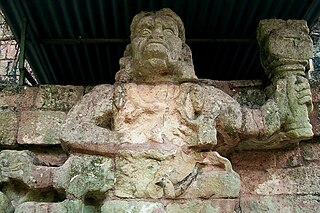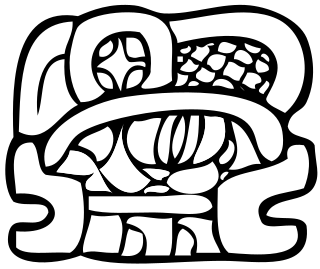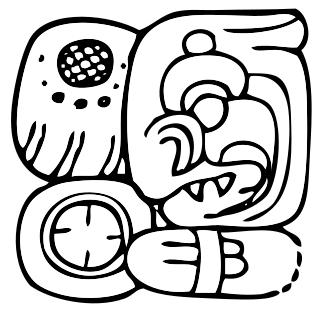
Copán is an archaeological site of the Maya civilization in the Copán Department of western Honduras, not far from the border with Guatemala. It was the capital city of a major Classic period kingdom from the 5th to 9th centuries AD. The city was in the extreme southeast of the Mesoamerican cultural region, on the frontier with the Isthmo-Colombian cultural region, and was almost surrounded by non-Maya peoples.
Itzam K'an Ahk I, also known as Ruler 2, was an ajaw of Piedras Negras, an ancient Maya settlement in Guatemala. He ruled during the Late Classic Period, from AD 639-686. The son of K'inich Yo'nal Ahk I, Itzam K'an Ahk I took the throne when he was only 12 years old. His reign was marked by several wars, and he seems to have had a special connection with Calakmul. Itzam K'an Ahk I died just a few days before the marriage of his son, who succeeded him as ajaw of Piedras Negras and took on the name K'inich Yo'nal Ahk II. Itzam K'an Ahk I left behind several monuments, including eight stelae stelae, three panels, a throne, and a short stela-like column; this made him the most active of Piedras Negras's leaders in regards to erecting monuments.

Zapote Bobal is the modern name for a pre-Columbian Maya archaeological site located south of the San Pedro Martir river in the Petén department of Guatemala. The name Zapote Bobal was coined by archaeologist Ian Graham, who discovered the site in the 1970s. It refers to the large number of Zapote Bobo trees, which grow near abundant sources of water in the Petén Basin. The site languished in archaeological obscurity until 2003, when epigrapher David Stuart connected the archaeological site of Zapote Bobal with a name repeatedly mentioned in the inscriptions of sites like Piedras Negras and Yaxchilan. That name was the toponym Hix Witz, or "Jaguar Hill" Scholars had recognized this name for over 20 years, and its connection to a real place prompted the creation of an archaeological project at Zapote Bobal in 2003, the Proyecto Peten Noroccidente (PNO). It is currently directed by James Fitzsimmons and Laura Gamez.

Lady Eveningstar was a Maya queen consort, wife of Itzamnaaj B'alam II, a Maya king of Yaxchilan. Their son, Yaxun B'alam IV - "Bird Jaguar", succeeded his father as king.

K'ahk' Pulaj Chan Chaahk, also known as Lord Chac before the decipherment of his corresponding name glyphs, is currently the only archaeologically identified ruler of the pre-Columbian Maya polity at Uxmal, who ruled in the early 10th century. Only a handful of details are known from this king, as hieroglyphic inscriptions, while very prominent in the Southern Maya Lowlands, are scarce in the north. What is known is that Lord Chac acceded to the throne somewhere at the end of the 9th century. During his rule, between 890-910 AD, some of the largest and most impressive buildings in Uxmal, such as the so-called Nunnery Quadrangle and the Governor's Palace, were built. An inscription at a large ballcourt in Uxmal, for playing the Mesoamerican ballgame, informs us it was dedicated in 901 during the reign of this king.

During the 7th and 8th centuries in Mesoamerica, there was an evident shift in the roles women played in ancient Maya society as compared with the previous two centuries. It was during this time that there was a great deal of political complexity seen both in Maya royal houses as well as in the Maya area. Warfare was a significant factor in political competition and marriage was one of the ways that alliances were made between the different polities. This was accompanied by a shift in women's roles from wife and mother to playing integral parts in courtly life, such as participating in rituals involving the supernatural world and at times ruling individual polities.

K'an Ahk II, also known as Ruler B was the second ruler of that Mayan city in Guatemala. He was a successor of Ruler A. He reigned c. 478.

Yat Ahk I was the third king of Mayan city-state Piedras Negras in Guatemala. He is also known as Ah Cauac Ah K'in, and by the English translation of his name, Turtle Tooth.

K'inich Yo'nal Ahk I, also known as Ruler 1, was an ajaw of Piedras Negras, an ancient Maya settlement in Guatemala. He ruled during the Late Classic Period, from 603–639 AD. It has been proposed that he began a new dynasty at Piedras Negras, following years of ineffective kings. As to how K'inich Yo'nal Ahk I came to power, a consensus has not yet been reached, although it is known that he waged several successful wars against Palenque and Sak Tz'i'. He was succeeded by his son, Itzam K'an Ahk I, in 639 AD and left behind several monuments, including stelae at Piedras Negras and a large mortuary temple now known as Pyramid R-5.

K'inich Yo'nal Ahk II, also known as Ruler 3, was a king of Piedras Negras, Maya city in Guatemala. He reigned from January 2, 687 until 729.

Itzam K'an Ahk II, also known as Ruler 4, was an ajaw of Piedras Negras, an ancient Maya settlement in Guatemala. He ruled during the Late Classic Period, from 729–757 AD. Itzam K'an Ahk II ascended to the throne following the death of K'inich Yo'nal Ahk II. Itzam K'an Ahk II may have fathered the following three kings of Piedras Negras: Yo'nal Ahk III, Ha' K'in Xook, and K'inich Yat Ahk II. Following Itzam K'an Ahk II's demise, he was succeeded by Yo'nal Ahk III in 757 AD. Itzam K'an Ahk II left behind several monuments, including stelae at Piedras Negras and a large mortuary temple now known as Pyramid O-13. In addition, the details of his life and his K'atun-jubilee were commemorated on Panel 3, raised by K'inich Yat Ahk II several years following Itzam K'an Ahk II's death.

K'ahk' Ujol K'inich I was a king of Maya city of Caracol in Belize, named after the Sun deity called Kinich Ahau. He is also known as Ruler I and Smoking Skull I. He reigned c. AD 470.

Scroll Serpent was a Maya ruler of the Kaan kingdom. He ruled from AD 579 to 611. He acceded on September 2.

Yuknoom Yich'aak K'ahk' ) or Yuknoom Ixquiac was a Maya king of the Kaan kingdom, which had its capital at Calakmul during the Classic Period of Mesoamerican chronology.

K'inich Yat Ahk II, also known as Ruler 7, was the last ajaw of Piedras Negras, an ancient Maya settlement in Guatemala. He ruled during the Late Classic Period, from 781 to roughly 808 AD. Possibly a descendant of Itzam K'an Ahk II, K'inich Yat Ahk II ascended the throne upon the death of his brother, the sixth ajaw of the site, Ha' K'in Xook. While K'inich Yat Ahk II presided over the destruction of the rival Maya site Pomona, his reign likely ended with K'inich Tatbu Skull IV of Yaxchilan capturing and subjugating Piedras Negras. Itzam K'an Ahk II left behind several monuments, including stelae at Piedras Negras, a stone seat known as Throne 1 which records either the death or abdication of Ha' K'in Xook, and Panel 3 which recounts the exploits of Itzam K'an Ahk II.
Parrot Chaak was a ruler of La Mar, an ancient Maya settlement in the Mexican state of Chiapas.
Lady K'atun Ajaw of Namaan, was the queen and consort of K'inich Yo'nal Ahk II, the king of Piedras Negras, Maya city in Guatemala. Coming from the city of Namaan, Lady K'atun Ajaw married K'inich Yo'nal Ahk on November 19, 686 CE, when she was just 12 years old. She would go on to have a child with him, Lady Juntaan Ahk, who was born on March 19, 708 CE, and the trio celebrated the closing of the 14th K'atun together on December 3, 711 CE.






















